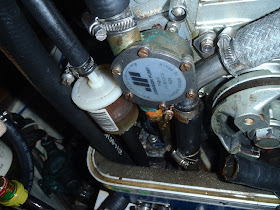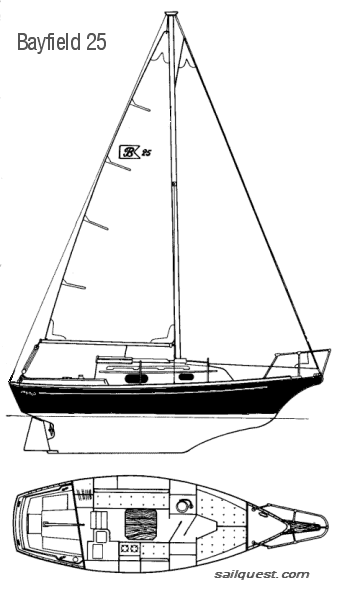Fischer Panda (FP) Generators are now cooled by fresh water and the sea water only passes through the heat exchanger and then out via the exhaust hose. BUT it didn't use to be that way. My FP is around a 2001 model, 5.5KVA. In my FP the cooling is done with sea water, which first goes around the generator casing and then to the heat exchanger, before exiting via the usual exhaust method. The fresh water gets circulated around the engine and through the heat exchanger to get cooled from the seawater that has picked up a little heat from the generator casing.
You can see the heat exchanger situated underneath the generator in the picture below. I consider that poor design and changed my heat exchanger location which you can read about here and also here
To change my cooling system, I figured it was only a case of changing a few hoses over and I could have both my generator casing AND my engine cooled by fresh water and use the raw water only for cooling through the heat exchanger. Read below how I did it...
FP blurb about their water cooling.
First I removed the freshwater hose that went from the engine to the heat exchanger. You can see the fresh water hose coming from the pump (above generator belt) to a metal tube which then does a small bend and goes down and sits just behind the Johnson raw water pump. The removed hose is sitting in front of the pulley.
Next I removed the hose from the raw water pump which goes straight down to a pipe that dives under the motor to the generator casing.
The idea is to swap these two over. Fresh water will now go to the generator casing, and raw water to the heat exchanger.
In the picture to the right, you will now notice, the pipe that sat under the raw water pump has been moved to the right a little and hooked up with the fresh water pipe coming down from the fresh water pump. (pump not seen). I had to cut about two inches (50mm) off the pipe so that a hose will connect.
I had this 20mm pipe (in picture to the left) made for this change over.
In the picture to the right, you can just make out the curved pipe as it is now attached to the raw water pump and the pipe continues to the heat exchanger underneath the pulley.
Now, at the heat exchanger. the pipe that use to be fresh water is now raw water and should be connected to the raw water input at the heat exchanger.... AND the raw water input hose at the heat exchanger is now fresh water. Just swap the two over.
So, lets follow the path of the fresh water first.
From the fresh water pump, it goes down beside the crank pulley and dives under the motor to the generator casing. From the generator casing, the fresh water goes to the heat exchanger to be cooled and then returned to the engine at the header tank. From the header tank, it gets circulated around the engine and repeats the cycle.
Now the raw water.... It leaves the raw water pump and goes straight to the heat exchanger; picks up the heat and then exits via the exhaust. Just like the new FP's.
Finale hookup with generator belt back on.
BUT, that's not the end of it. You might imagine that the generator casing may have some internal salt deposits. So, I first ran the engine up with fresh water to temperature and then after cooling down some, drained that water away. I then did another run up using a product called "Salt-X". I mixed with water as per directions and repeated the draining of the fluid after cooling down some. This Salt-X is a produce for removing salt deposits in outboard engines and should be available in most marine Chandler stores. Finally, I did another fresh water run up and emptied that too, before using a ethylene glycol "antifreeze/antiboil" product. I'll change that in about 9 months time as well; to make sure all salts that remained have left the cooling system.
We also have a fresh water flush system for both our engine and Genset. As we get ready to shut them down for a while, we open a valve to our fresh water tank and close the sea cock. We let the engine run for a minute or two and this then flushes out the seawater from the heat exchanger. Thus prolonging the life of the heat exchanger. Then, after shuting down the motor, it is important to close that fresh water valve; otherwise, the next time you open the sea cock, it can back pressure to the fresh water and ruin your tank supply. It usually only happens once. :-D
All up, it took about 2 hours and a ten dollar item to complete. Antifreeze and Salt-X were extra costs; but you should replace you antifreeze once a year anyway. It's mostly for the anti corrosion properties that we use it.The engine actually runs slightly cooler, and with a trip up to the tropics soon, will be beneficial.
When I was a small kid back in the communist Czech and Slovak Socialistic Republic, a friend of mine introduced me to this marvelous new gadget – a digital watch. The Vietnamese throw them into the garbage when the battery is dead, said my friend. Yes, that marvel was battery operated. I’ve never seen battery operated watch. Why wouldn’t the Vietnamese replace the battery instead of tossing the whole watch I didn’t understand. My friend just shook his head and pointed out to me again that the fact that these can be found in garbage cans is what I should be concentrating on.
Surely I did peek to garbage cans for a while then before emptying the content of our household bin. Yes, there were no plastic bags used then. All went to the bin, we would fold an old newspaper on the bottom, and the bin would have to be cleaned from time to time, because it would start to smell quite badly. I guess we were quite ecological back then, regardless of the fact that people didn’t know much about being ecological.
But the times they are a-changin’ and we buy and discard on a daily basis. Those who take a screw driver and disassemble are breaking warranties and are being labeled as handyman or in more contemporary lingo as hackers.
I digress, however. We try to remain faithful to our promise to the mother Earth and create as little garbage as possible. Thus, knife in one hand scissors in the other, I started butchering one of our old mainsails. You see, right now we have three mainsails on board. A very old one, then the one that was rigged when we bought the boat and now the new one, we just bought in Hong Kong. The time for the other too has come, holes here and there and patches, chafed all around, grommets corroded, leech lines, stuck to the fabric.
I stretched that large piece of shred and started to plot my attack. We need leecloths, helmsman awning, weathercloths, and couple of bags for lines, bag for cloth pins, there’s never enough bags on a boat. So far we’ve been using plastic bags (sic), because there’s such an abundance of those things and especially in Taiwan, most things are usually packages at least twice. Receiving piles of plastic bags seems unavoidable, but it’s time for us to say no. Not to mention that some of the plastic bags are so noisy.
So after a few hours effort, we got new leecloths, bottom firmly screwed to our berths and the top hanged on the cabin handholds and a massive eye through bolted to a bulkhead. We can stretch nice helmsmen awning, called “the square” over our cockpit. Our 100m mooring lines are now stowed properly in their own bags, line flaked inside so that it can be let out quickly without snags. And we have a new bag for a mainsheet in the cockpit (the photo of which will remain unpublished, because it’s a recycled cover from an outboard and it does not look particularly nice – but it works…).
In the conclusion I can say only this: Long live our fabulous Singer machine!















